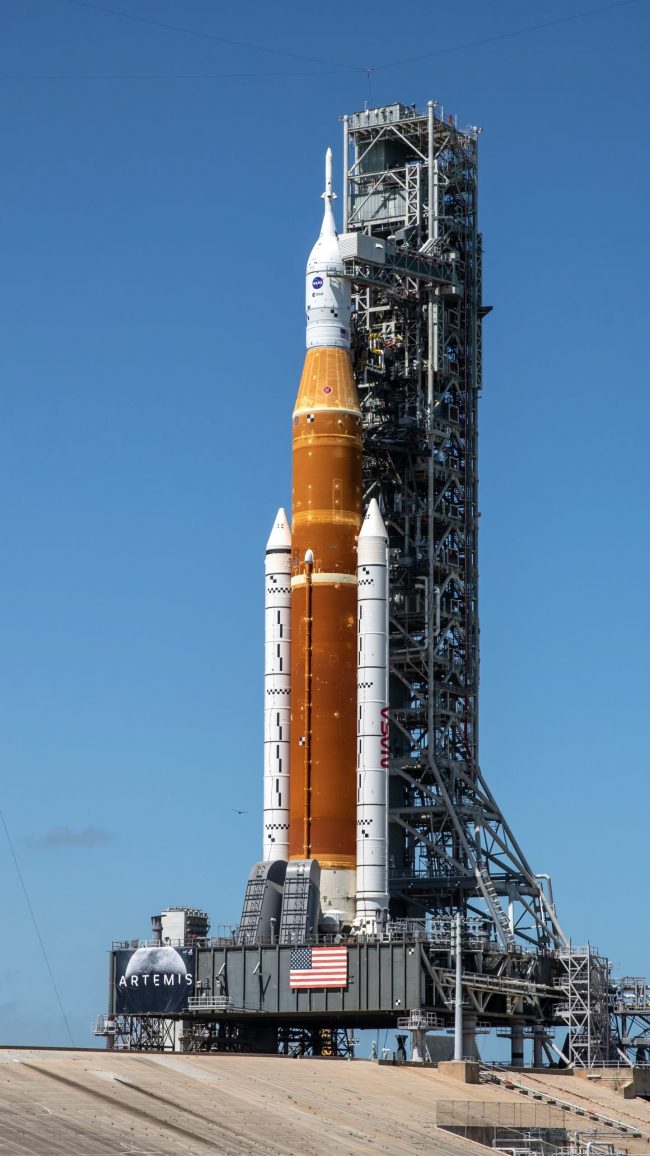
Starship and SLS
Humanity is on the edge of a spaceflight revolution … maybe.
With the two largest, most powerful rockets humanity has so far created both weeks (or months) away from taking their first flights out of Earth’s atmosphere, space scientists are busily drawing their plans for future deep space missions, according to an April 12, 2022, report from Jonathan O’Callaghan at the venerable popular science magazine Scientific American.
Pointing to the cargo constraints our current fleet of space-going vehicles suffers, O’Callaghan paints a picture of “eager scientists” dreaming up new and exotic missions to destinations that remain unreachable even now as the parallel development of NASA’s Space Launch System (SLS) and SpaceX’s Starship Heavy Lift Vehicle come to near simultaneous completion. Both launch systems will be larger than the Saturn V that first carried humanity to the moon and which remained until now the biggest, most powerful machine to ever fly.
To exemplify that new spirit of hope, SciAm quotes Alan Stern of the Southwest Research Institute in Texas. Stern was head of NASA’s New Horizons mission that reached Pluto in 2015, and he had this to say:
These rockets can enable whole new classes of missions: to all the giant planets and the Kuiper belt objects, to the ocean world satellites and the dwarf planets of the solar system. They’re across-the-board useful.

Huge rockets are the future and the past
The concept of oversize rockets Stern is praising is not new. The big dumb booster (BDB) has been a staple of both pulp science fiction and the fanciful dreams of engineers since the heady early days of the Space Race.
Back in 1962, the folks at Aerojet whipped up plans for the Sea Dragon, a two-stage heavy lift vehicle that would have launched while bobbing like a cork in the ocean. A few years later, the German company OTRAG designed a two-stage BDB that looked very much like the modular design of United Space Alliance’s Delta IV Heavy or SpaceX’s Falcon Heavy. Also like SpaceX, OTRAG focused on mass production for reduced cost.
Cost isn’t really a factor for NASA, as it builds the SLS with a slowness spaceflight enthusiasts find painful to watch. The project is years behind schedule and billions over budget, and only a handful of the rockets will be built during the foreseeable and ever-changing future at NASA.
SpaceX, which until 2018 referred to the Starship as the “Big Falcon Rocket” or BFR, is obviously taking a different approach to development of its BDB.
NASA’s SLS is already booked up
SciAm reports that the most serious would-be future solar system explorers are making their plans to go where no humans (or more likely our robotic probes) have gone before based on access to the SLS and its supposedly more mature space shuttle-based technology. But in the next breath, SciAm tells readers the plans NASA has now for the 10 SLS single-use launch vehicles it plans to build and fly make such pure science missions unlikely to leave Earth via that route. All 10 of those rockets are reserved for the Artemis mission’s return to the moon.
There’s even a smoking-gun quote from Robert Stough, payload utilization manager of the SLS at NASA’s Marshall Space Flight Center, in SciAm’s report:
Given the demands of the Artemis program between now and the late 2020s, it’s going to be very difficult to squeeze a science mission in that time frame.
More risk means more reward with Starship
That means the SLS won’t be freed for scientific missions until the 2030s at the earliest, if it ever is at all. The folks who want to fly formerly impossible missions to places like the Kuiper Belt, the watery moons of Saturn or even beyond our solar system know what’s up regarding the availability of the SLS versus Starship. They are, after all, rocket scientists. SciAm quotes Stern again:
Starship holds the promise of transforming the solar system in a way we can’t really appreciate. It completely changes the game.
The rocket scientists aren’t saying the same about the potential of the SLS, at least not until well into the 2030s or even the 2040s. The SLS, even though the prototype is sitting on the launch pad undergoing final testing right now, still seems like the distant future. Starship, which has already flown low-altitude test flights, and crashed, seems like right now.
Starship also seems like a more practical rocket for an age of financial uncertainties. While SciAm reports SLS will cost $4.1 billion per launch, the reusable nature of Starship has SpaceX CEO Elon Musk hoping its per-launch cost could eventually reach as little as $10 million.
Regardless of which launch system performs what tasks, the excitement is palpable as human hopes to finally make a mass movement beyond Earth. To exemplify the anticipation, SciAm quoted Kirby Runyon of the Johns Hopkins University Applied Physics Laboratory, who is part of a proposed mission to probe the atmosphere of Neptune.
There’s a ton of excitement about what really high-performance rockets will enable. The solar system really opens up in a way that’s never been done before.
Bottom line: SpaceX’s Starship and NASA’s SLS are the two largest, most powerful rockets humanity has created so far. Both will soon take first flights out of Earth’s atmosphere. Some are saying they will herald a “spaceflight revolution.”











